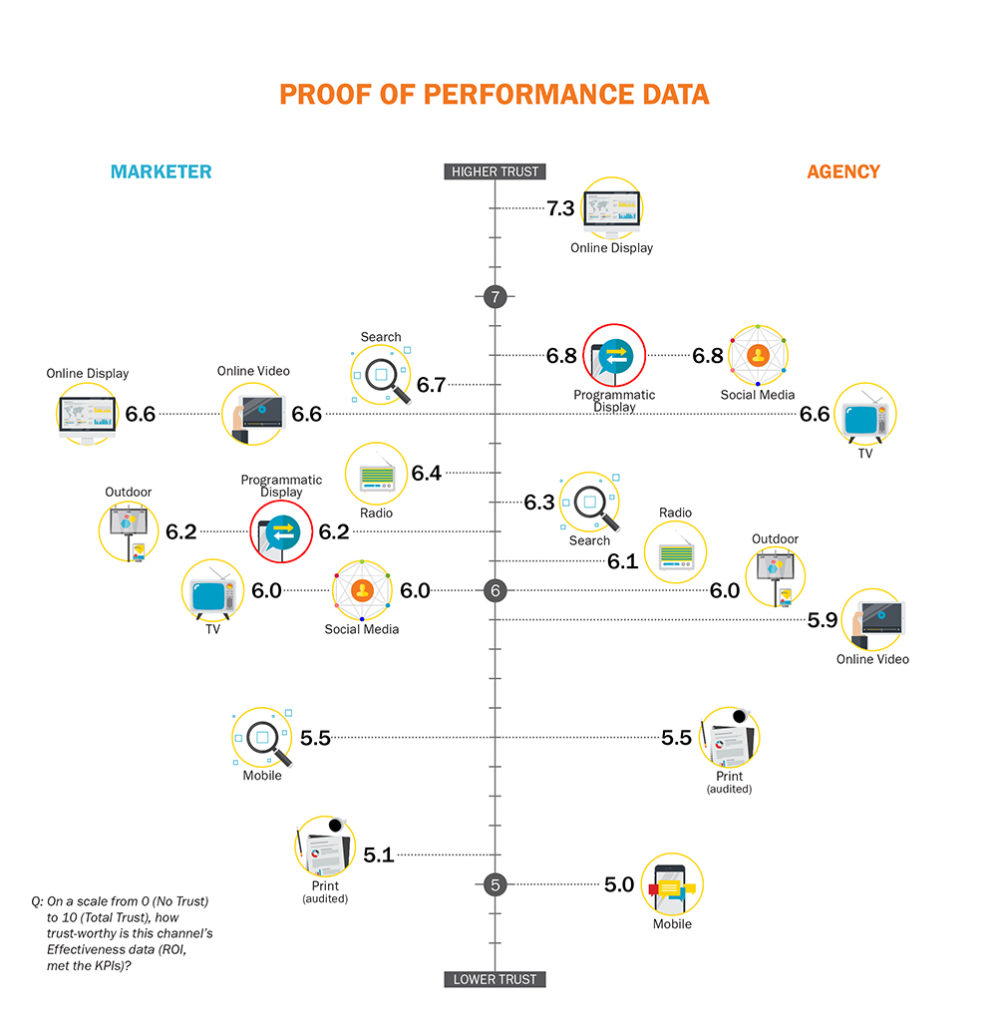
READING TIME 5 MINUTES
Research conducted by the Audited Media Association of Australia (AMAA) has found trust in programmatic advertising is lagging for both media agency professionals and marketers. When it comes to transparency, verification and brand safety, marketers are actually more trusting than agencies.
The online survey of 315 Australian client-side marketers and media agency professionals found marketers score programmatic display 5.7 out of 10 where 10 equals total trust in the medium while agencies give it 4.8, equal to agency trust levels in mobile.
In addition to researching whether both parties see each channel as safe, transparent and verified, survey respondents were quizzed on audience data focusing on total reach, insights, and behaviours as well as ROI data and the measurable impact across channels from the many facets of digital to print, TV, outdoor and mobile.
In terms of audience data, the research found media channels providing high frequency, granular data such as clicks and views are the most trusted with agencies rating online display highest. Marketers lean toward online video as the most trusted for audience data. Programmatic display, however, scores 5.8 and 5.9 with marketers and agencies respectively. This figure is on par with marketers trust in audience data for radio and outdoor.
Programmatic more trusted for ROI than TV
Still, there is good news for programmatic. When it comes to ROI, programmatic display is among the top three channels for agencies alongside social media with non-programmatic online display surging ahead slightly.

Marketers also rate non-programmatic online display ahead of programmatic display and they see search, online video and radio delivering better ROI than programmatic display. In fact, marketers see outdoor as ranking on par with programmatic when it comes to seeing a return on their investment.
Tellingly, both marketers and agencies score programmatic display higher than TV for ROI.
In January, RocketFuel’s JJ Eastwood told Ashton Media: “By 2018 there will be at least a billion dollars flowing through programmatic pipes in Australia. So that’s a relatively big business. And then the bigger number, which a lot of people are excited about, is that by 2020 there will be $100 billion flowing through programmatic pipe globally.”
Data from the AMAA research gives us an indication as to why ad spend continues to move away from traditional channels to digital. While there may be less trust in transparency, verification, brand safety and audience data, both agencies and marketers see programmatic as having a better return on investment than traditional mediums such as print and TV.
Challenges and opportunities for programmatic in a world of accountability
The research found opportunities for premium publishers that deliver content via private ad exchanges as the lack of trust in online video, mobile and programmatic means these publishers can take the high ground on account of their traffic being audited. This leaves open exchanges out in the cold.
From the marketer’s perspective, while a number of brands are building their own in-house programmatic function, according to the research, many others describe themselves as “flying blind” as they struggle to get their heads around and keep up with the advances in technology and the opportunities available to them. The AMAA research suggests this highlights a key opportunity for agencies who are able to guide their clients through the tech landscape, an opportunity management consultancies are also eyeing off.
Building trust in programmatic
Overall, both marketers and media agencies see the digital advertising ecosystem to be the channel most in need of oversight with 54% of survey respondents identifying this area. By comparison, only 16% of marketers and agencies say radio needs more oversight. Within the digital space, marketers are most concerned about being able to better trust social media compared to agencies that say programmatic.
With the research finding audited data has nearly twice the trust of unaudited data, and that the industry can benefit from embracing independently audited data and best practice verification frameworks, it seems programmatic could well gain an advantage from independent oversight.
The AMAA white paper reads: “With more media moving towards programmatic that increases the risk for fraudulent activity. We must, as an industry, stand up to it and demand more accountable practices on behalf of our clients.”
The AMAA sees a need for governance, particularly when it comes to the issue of viewability, which is supported by agency groups such as GroupM that earlier this year forged a deal with nine publishers to give their clients the guarantee of 100% viewability. Still, in terms of issues around programmatic, industry executives at this year’s Programmatic Summit put viewability below ad blockers and ad fraud when asked which threatened the industry most, which was backed up by the AMAA’s research.
If independent governance is able to help programmatic to overcome the issues it is currently grappling with, the desire to utilise it could expand exponentially. And with programmatic practices coming soon to TV, outdoor and other channels, establishing a framework in the online space could have untold benefits for theses channels down the line.
Take a moment to picture what the media landscape would look like if both agencies and marketers saw programmatic as trustworthy in terms of transparency, verification and brand safety as they believe it to be capable of delivering return on investment.
The Programmatic Forum will be held on July 20. Click here to find out more.
About Mark Abay - Content Director, Ashton Media
Mark is Content Director at Ashton Media. It's his job to create interesting and engaging conference programs that stretch the thinking of our attendees. Mark works closely with our industry advisors to ensure the conference content is aligned with the needs and interests of our audiences.

